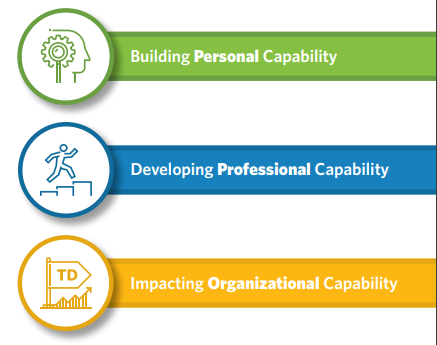ATD Blog
Ready for ATD's New Capability Model?
Wed Nov 13 2019

Bookmark
For more than 75 years, an important part of ATD’s work has been to establish standards of excellence for our profession through our competency research. Best practices and expectations for the field have kept pace with changing times, and ATD’s commitment to equipping others to develop talent in the workplace remains strong.
To help talent development professionals stay current on knowledge and skills that are important for success, ATD updates its competency model every five to seven years. The most recent model was released in 2013.
In late 2018, ATD began the research to update its competency model. In addition to capturing major shifts in society and the larger business landscape, the study also identified changes in talent development since the previous model was published. The research process included a literature review, expert practitioner interviews, a comprehensive survey, and discussions with an advisory panel of thought leaders. The purpose of the research and analysis was to ensure that the model reflects current talent development practice today and five years into the future.
From Competency to Capability: the Talent Development Capability Model
While past studies have resulted in a competency model framework, ATD’s focus has broadened to helping talent development professionals build capability that will help them perform their work today and prepare for challenges they’ll face in the future. Competence refers to a person’s current state and having the knowledge and skills necessary to perform a job. Capability is about integrating knowledge and skills and adapting and flexing to meet future needs. Shifting from a competency model to a capability model signals to talent development professionals that they must be agile and committed to continual development to successfully create, innovate, lead, manage change, and demonstrate impact.
What’s in the New Model?
The model answers the question: What should talent development professionals know and do to be successful? This process begins with the identification of the underlying personal and professional attributes required or expected of talent development professionals in relation to their performance at work and ends with the development of a graphic illustration to show the major capability areas needed by individuals in the field.
ATD’s Capability Model is structured around three domains of practice (see figure below). These domains comprise capabilities that:
Derive from interpersonal skills.
Come from building professional knowledge related to developing people and helping them learn.
Affect an organization’s ability to drive toward results and success.

In today’s competitive business landscape, talent development professionals must leverage interpersonal skills along with their professional expertise to work as true business partners to help achieve organizational goals. ATD’s research shows that successful talent development professionals need to blend knowledge and skills from all three of these domains of practice to be most effective now and in the future.
ATD members will get an advance preview of the new model through an interactive site that will debut on Monday, December 16. A members-only webcast on December 17 will provide an overview of the model and a guide to using the interactive site. The study book Capabilities for Talent Development: Shaping the Future of the Profession is available for pre-order now and will publish in December.
More information about each domain of practice and the individual capabilities will be included in this ongoing blog series. Frequently asked questions are included on the Capability Model webpage, and additional questions may be sent to ATD at capabilitymodel@td.org.

